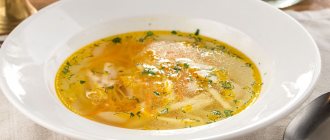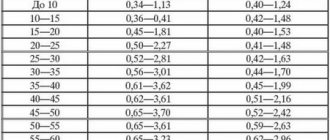Various forms of food poisoning and diseases of the intestinal tract of an infectious nature are the main cause of disruption of the digestive tract and deterioration of the microflora of internal organs. Treatment of the pathologies listed above is based on the use of comprehensive measures, including taking medications and following a gentle diet.
The basic principles of a therapeutic diet are moderation in food and quality of products.
Diet for poisoning and intestinal infections is the main treatment tool, helping not only to reduce severe symptoms of intoxication, but also to restore and normalize the functioning of the digestive tract. Failure to comply with dietary norms and rules can lead to relapse of the disease and the development of underlying diseases of the gastrointestinal tract.
Forms of poisoning
There are several forms of poisoning, which differ depending on certain factors:
- acute poisoning. Occurs when large amounts of toxins enter the body over a short period of time. The cause of poisoning can be food, household chemicals, medicines, gases, etc.;
- chronic poisoning. They occur when exposed to the toxin in small portions over a long period of time. The most common source for this form is poisoned water, gas vapors, or small portions of toxic substances in food or cosmetics.
With vomiting
Vomiting is one of the first symptoms of poisoning. It can occur when toxins enter the body with food, poisoning, etc. Vomiting is not a separate disease, but only a reflex and a symptom of a disease or condition of the body.
The degree of poisoning can be determined by the nature of vomiting:
- with food or with watery contents - characteristic of ordinary etching, after which healing occurs;
- with bile – characteristic of severe poisoning, a sour taste remains in the mouth;
- in the form of coffee grounds - indicates damage to the intestinal walls, possible poisoning by toxins and poisons, household chemicals;
- with blood – a sign of damage to the esophagus and stomach.
If vomiting occurs 1-2 times, do not worry. But with frequent episodes, especially against a background of high temperature, this threatens with dehydration - medical help is needed.
With diarrhea
Diarrhea is a health and life-threatening condition of the body in which bowel movements occur 3 or more times a day, and the stool is watery. Often accompanied by abdominal pain. In case of poisoning, diarrhea occurs when drinking dirty water, fruits or vegetables, poor sanitation of dishes, eating areas, etc.
Diarrhea is a sign that dangerous microbes have been introduced into food or water. Even minor diarrhea can lead to dehydration within a few hours. It is especially dangerous for young children, so those who become ill are immediately hospitalized.
Nutrition rules for intoxication
To make it easier for an adult to recover, you must adhere to the following rules:
- Maintain drinking regime. Drink at least 2 liters of liquid per day - still water, sweet and sour juices, herbal or rose hip decoctions, tea, jelly. For additional rehydration, you can use Oralit and Regidron saline solutions.
- The first days of food poisoning are fasting days. The daily volume of portions should not exceed 150-300 grams, gradually increasing the amount eaten.
- Stick to fractional meals. Eat food in small portions, but often - 5-6 times a day.
- Food must be thermally processed. Acceptable: boiling, steaming, baking. Frying must be completely avoided.
- Vegetables, meat, fruits should be consumed in grated or pureed form. Chew thoroughly.
- Salt consumption should be limited to 6-8 grams per day.
The basis of the diet after poisoning in adults
After the body “gets rid” of toxins and poisons after poisoning with vomiting and diarrhea, it becomes severely depleted, the gastric mucosa at this time is irritated, and ulcers appear on it. Together with the fluid, a huge amount of salts, vitamins and proteins are “washed out” from the body.
At this time, it is important to restore strength, but not to burden the damaged gastrointestinal tract. In the first days, there are enough products to maintain strength. Mashed porridges and rosehip compotes without sugar are ideal for this.

On the second or third day, it is necessary to introduce meat products, lean, without cartilage and tendons. The meat used is dietary and well-cooked. This helps to compensate for the lack of proteins, restore blood composition, improve the functioning of the kidneys and liver, which suffer greatly during poisoning.
After severe vomiting, the body needs to replenish lost fluid. But you shouldn’t be too zealous, especially with salt water, so as not to overload the kidneys after poisoning.
The diet for poisoning in adults may include sorbents, both natural (herbal decoctions) and in the form of medications; they cannot be used for several days in a row. But they cannot be used for a long time: along with toxins, they also introduce vitamins and microelements that are beneficial to the body.
For what conditions is it prescribed?
Therapeutic nutrition is necessary not only during the diet, but also after, as a restorative method.
What should be the diet for poisoning? Food poisoning affects the organs of the digestive system. They are affected by toxins, cannot cope with the task assigned to them, and their microflora deteriorates.
You can’t eat as before at this moment; you can only aggravate the condition. Liquid meals that are easily digestible are needed. They normalize the functioning of the stomach, liver and intestines.
To remove toxins from the body, you need to drink a lot of water , eat fruits and vegetables. Gradually, there will be no harmful substances left in the body. The recovery stage will begin.
If the poisoning is overcome, the person gradually recovers, it is necessary to continue to eat properly, following all the rules.
Immediately after poisoning, you should not eat heavy food that is difficult to digest. It is necessary to normalize metabolism, fill the body with vitamins and minerals.
Tables according to Pevzner: rules, permitted and prohibited products
Diets or dietary tables according to Pivsner were developed by the scientist of the same name for the treatment and recovery of humans after illnesses and surgical interventions. This also includes unloading tables.
Dietary table No. 0
Diet for poisoning in adults No. 0 is prescribed in the first days after poisoning and if the person is unconscious. Diet No. 0 is used in cases where the quantity and variety of the diet is strictly limited, the body is not able to digest solid food, and the gastrointestinal tract cannot be overloaded. The calorie content of food per day should not exceed 800 kcal.

Diet for poisoning in adults prohibits the consumption of fried, smoked and hard-to-digest foods
Basic diet requirements:
- food should be warm;
- amount of salt per day – do not exceed 1 g;
- number of techniques – 7-8;
- You should not consume more than 300 g at one time.
On the first or second day after poisoning:
| Allowed | Strictly prohibited |
| Puree porridge | Dairy |
| Juices diluted with sweetened water | Alcohol |
| Jelly based on fruit juices and compotes | Grape juice |
| Rosehip compote | Vegetable juice |
| Sour jelly without solid parts | Solid food |
| Meat broth without fat | Puree |
| Sparkling water |
On the third to fifth day after poisoning:
| Allowed | Strictly prohibited |
| Porridge with milk or broth | Soda |
| Soups with semolina in low-fat vegetable or meat broth | Alcohol |
| Steamed cutlets made from lean meat and fish | Vegetable juices |
| Steam omelettes | Whole milk |
| Rough food |

On the fifth or sixth day after poisoning. The transition from a special diet to a regular diet begins.
| Allowed | Strictly prohibited |
| Dairy products | Fast food |
| Baked apples | Alcohol |
| White bread crackers | Rough food |
| Cottage cheese | |
| Fruit and vegetable puree | |
| Tea with milk |
Dietary table No. 1a
The dietary regimen No. 1a is considered quite strict and is prescribed for stomach or duodenal ulcers. Can also be used after poisoning and surgery. You can follow the diet for a maximum of 2 weeks. Nutrition promotes healing of damaged areas of the stomach and intestines.
Diet for poisoning in adults No. 1a has the following features:
- meals are only fractional;
- food should not be hot or cold;
- number of appointments per day 6-7 times;
- Drinking milk at night is allowed;
- daily caloric intake 1700 – 1800 Kcal;

| Allowed | Strictly prohibited |
| Mucus soups with milk, egg suspension | Bread |
| Vegetable oil | Vegetables |
| Steamed fish puree | Pasta |
| Steamed cutlets from lean meat | Marinades and seaming |
| Milk, cream, low-fat cottage cheese | Dairy products |
| No more than 3 eggs per day (boiled) | Compotes |
| Sweet dishes | Carbonated drinks |
| Sweet juices | Tea coffee |
| Tea with milk | Porridge from coarse cereals |
| Puree porridge with milk or butter | Sour berries |
| Foods that cause flatulence |
After two weeks, the patient is transferred to normal nutrition with restrictions or to dietary table No. 1b.
Dietary table No. 5
Dietary table No. 5 is prescribed for diseases of the liver and pancreas, as well as after severe poisoning at the stage of recovery of the body. The basis of the diet is to limit fat intake.
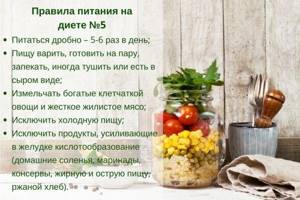
Features of dietary table No. 5:
- water consumption – 2 liters per day;
- quantity of dairy products – no more than 200 per day;
- the number of calories per day is no more than 2800.
| Allowed | Strictly prohibited |
| Fruits and berries | Fried foods |
| Puddings | Spicy dishes |
| Pasta | Animal fats |
| Cracker | Salty |
| Sweets | Chocolate |
| Berry sauces | Mushrooms |
| Lean meat | Cold drinks |
| Berry sauces | Vinegar |
| Mild cheese | Sour citrus fruits |
| Legumes | |
| Green vegetables, herbs | |
| Entrails |
Duration and exit rules
This diet continues for 1-2 weeks. It can be extended up to three weeks, but no more than this period: the diet is not balanced.
After this time, the patient recovers. He can go off the diet.
However, you should first consult with your doctor, who will monitor the patient’s recovery.
They leave the diet very carefully, gradually increasing portions and eating more solid foods. Products from the list of prohibited items are included in the menu in small quantities.
You will learn even more useful information about proper dieting during and after food poisoning from this video:
Diet during and after poisoning is necessary. It normalizes metabolism, helps remove toxins from the body, and creates healthy microflora in the gastrointestinal tract.
Thanks to proper nutrition and compliance with certain rules, the patient will quickly recover and recover.
Do you like the article? Rate and share with friends on social networks!
Subscribe to site updates via RSS, or follow updates on VKontakte, Odnoklassniki, Facebook or Twitter.
Subscribe to updates by E-Mail:
Tell your friends! Share this article with your friends on your favorite social network using the buttons below the article. Thank you!
Poisoning can occur when consuming low-quality food, alcohol, various chemicals, as well as when pathogenic microorganisms penetrate the digestive tract. This condition is accompanied by characteristic symptoms: vomiting, diarrhea, intoxication and hyperthermia. It should be noted that for recovery it is necessary to follow a therapeutic diet.
Features of the diet for poisoning in pregnant women and breastfeeding
The occurrence of poisoning is especially dangerous for pregnant and nursing mothers, because poison or pathogenic microflora can penetrate into the child’s body. Therefore, at this time, doctors recommend giving up smoked food, mushrooms and canned food. Here, young mothers can be “waited” by deadly bacteria and toxins.
Typically, the first symptoms appear within 30 minutes after poisonous substances enter the body. At the first appearance of vomiting or diarrhea, it is necessary to increase water consumption.

In this case, a special solution is best suited: 1 tsp per 1 liter of water. salt and soda and 1 tsp. l. with a pile of sugar. This will help prevent dangerous dehydration in pregnant women and maintain breastfeeding. In case of poisoning, breastfeeding should be discontinued.
If doctors usually recommend abstaining from food after poisoning for 24 hours, then this should not be done for pregnant and nursing mothers. After the vomiting has stopped, you need to eat a little.
Suitable for the first meal:
- warm water with sugar (if there is severe poisoning and the body does not accept other food);
- rice porridge (in water, pureed);
- strong tea with sugar;
- a cracker of white bread;
On the second day you can expand your diet:
- baked apple;
- low-fat chicken or veal broth;
- some mashed potatoes;
- a glass of kefir;
- 5-7 spoons of natural yogurt;
A week after poisoning, you can add steamed meat and fish without fat to your diet. At the same time, it is necessary to abandon fresh vegetables and fruits, since plant fibers at this time can provoke attacks of diarrhea. After a month, you can eat fried foods, fatty meats, and fresh dairy products.
Pros and cons of the method, contraindications
The diet is recommended for use by doctors and nutritionists.
Its advantages:
- The water and electrolyte balance in the body is restored.
- The level of intoxication decreases.
- The menu is quite varied, the patient does not get bored.
- Highly effective therapeutic diet, proven in practice.
- Beneficial effects on the body.
The only disadvantage of this diet is that it is not balanced, you cannot follow it for a long time - no more than 2-3 weeks. She has no other deficiencies identified.
Contraindications to dietary nutrition in case of poisoning include pregnancy, lactation and the presence of chronic diseases. In severe cases, you can stick to a diet; it will not harm.
How to properly introduce foods into the diet after poisoning
Any poisoning causes a strong blow to the gastrointestinal tract. When damaged by toxins, the liver may suffer due to insufficient enzymes. In the first days after poisoning, it is important to restore healthy mucous membranes of the stomach and intestines, improve the well-being of the victim and restore the lack of fluid caused by vomiting and diarrhea.
- On the first day, you must avoid salty, hard, hot and cold foods. The ideal diet at this time is rice porridge with a minimum amount of salt. Rice is an excellent remedy that simultaneously adsorbs harmful substances and is a source of energy. On the first day after poisoning, pureed rice porridge should be consumed 7-8 times, several tablespoons each.
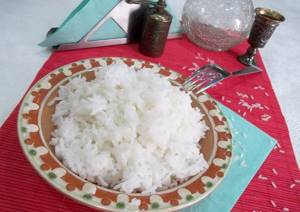
- On the second day, you can add other grains to the menu: millet, buckwheat, etc. All porridges should be pureed as much as possible. They need to be cooked without adding salt, onions, jam, butter or milk. To restore strength, you can prepare broth from homemade chicken or fresh meat without fat and seasonings. Oven-baked apples without core or peel are perfect as a dessert. Before serving, the apples are mashed into puree; you can add a little sugar.
- On the third day, meat products are allowed. Everything should be boiled or steamed. At this time, solid food particles can be a burden on the gastrointestinal tract, so it is better to prepare steamed cutlets or meatballs with minced meat as ground as possible. Between meals, you can consume fermented milk products without dyes or sweeteners.
- After a week of a strict diet, you can introduce whole milk products, roughage and plant fibers into your diet, but you must give up vegetables and fruits that cause increased gas formation.
- After a month, you can eat fatty and spicy foods, juices, sparkling water, coffee, any fruits and vegetables, smoked foods, nuts, peas and beans.
Recommendations from nutritionists for the duration of compliance
To increase the effectiveness of the diet, it is recommended to eat fresh vegetables: heat treatment destroys vitamins.
If you are preparing a salad, use olive oil - it is more nutritious. To dress fruit salads, use natural yogurt without dyes or flavors.
If you feel hungry, you can’t tolerate it: you need to eat something. This could be fruits, vegetables, cereals or boiled eggs.
Feelings of heaviness in the stomach should be avoided, portions should be minimal. Increased load on the digestive organs during this period is detrimental and will slow down the recovery process.
Drinking when poisoned
Drinking is an important step in treating poisoning. Through vomiting and diarrhea, the body tries to get rid of poisons, toxins and bacterial microflora, but at the same time loses a huge supply of not only water, but also electrolytes, as well as glucose. Dehydration occurs, which in severe cases leads to death.
If vomiting and frequent bouts of diarrhea occur, it is necessary to start taking a solution that restores the water-salt balance. You can buy the powder for preparation at a pharmacy or prepare it yourself. To do this, take 2 parts sugar and 1 part salt or soda per liter of water.
In case of mild poisoning, this solution can be replaced with tea with a lot of sugar. You need to drink in small sips as often as possible. It is not recommended to drink pure water; the absence of minerals and glucose will not save you from dehydration.
For stomach pain, tea made from fresh lemon balm and dill leaves will help. It will relieve painful spasms, ease vomiting, and help get rid of gases in the intestines.
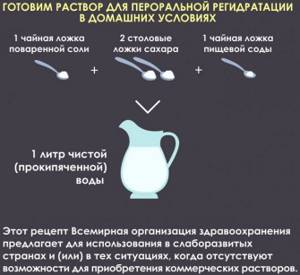
The diet for poisoning in adults on the first day involves taking a decoction of rice, warm teas from currant leaves, dried blueberries and rose hips. They not only have the ability to adsorb toxins, but also supply the body with vitamin C.
A day after poisoning, compote of dried apples is allowed. Pears and dried fruits cannot be used for this. They provoke gas formation and diarrhea.
2 days after poisoning, fermented milk drinks must be introduced into the diet. Low-fat kefir or liquid yogurt is best for this. They will help restore damaged mucous membranes and restore microflora.
Its effect on the body
This diet is healthy and has a beneficial effect on humans . It normalizes metabolism, restores the functioning of the digestive system, and removes toxins.
The diet leads to the fact that it is possible to normalize healthy microflora in the organs, and harmful microorganisms are eliminated.
We must not forget that the menu includes many healthy foods that saturate the body with vitamins and minerals.
They help boost immunity. restore protective properties, give strength and energy. The man soon recovers.
Recipes and menu for a week for poisoning with vomiting and diarrhea for adults
Doctors recommend following a diet for adults from 1 week to a month, depending on the severity of the poisoning.
Day 1
- Breakfast is a slimy rice porridge. To prepare it, you need to take 1.5 times more liquid than to prepare regular porridge. You need to cook over low heat for 40 minutes.
- Lunch – chicken broth. The meat, cleaned of fat and skin, is cooked for 10 minutes over high heat. The first broth is drained. Then cook with a little salt for 15-20 minutes.
- Afternoon snack – half a banana.
- Dinner - yogurt.
Day 2
- Breakfast - oatmeal. The porridge is cooked according to the usual recipe and then strained through a colander.
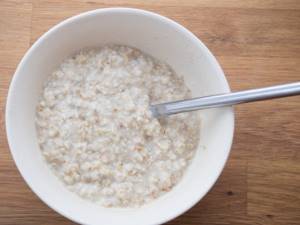
- Lunch – steamed potatoes. It can be prepared by leaving the sliced potatoes in a steamer for 30-35 minutes.
- Afternoon snack – a piece of avocado.
- Dinner – boiled chicken fillet.
Day 3
- Breakfast – buckwheat porridge with milk.
- Lunch – chicken broth with broccoli. Brocolli can be cooked at the same time as chicken in salted water.
- Afternoon snack – baked apple. For those who have a sweet tooth, you can add a little honey to the apple.
- Dinner – boiled omelette. To prepare it, several eggs are beaten and then poured into a plastic bag. The omelette is cooked for a few minutes in a double boiler.
Day 4
- Breakfast – salad of grated boiled carrots with honey.
- Lunch – boiled buckwheat with chopped turkey fillet.
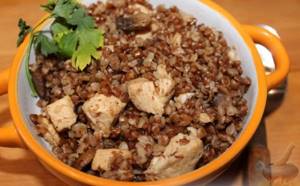
- Afternoon snack – currant broth with white crackers.
- Dinner – oven-baked vegetables with sour cream. Potatoes, carrots, and broccoli are used for baking.
Day 5
- Breakfast – sweet berry salad with natural yogurt.
- Lunch – chicken with stewed cauliflower.
- Afternoon snack – boiled eggs.
- Dinner - boiled zucchini puree with butter.
Day 6
- Breakfast – cottage cheese casserole without crust with sour cream.
- Lunch – vegetable stew (without frying).
- Afternoon snack – low-fat kefir with biscuits.
- Dinner – salad of boiled carrots, potatoes and beets with sunflower oil.
Day 7
- Breakfast – steam omelet with milk.
- Lunch – rice soup with steamed chicken meatballs.
- Afternoon snack – apricot.
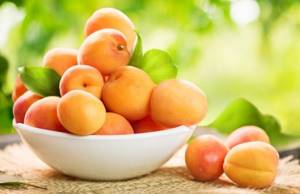
- Dinner – veal cutlets with potatoes.
General characteristics of the pathology
Poisoning is a fairly common occurrence. All people are susceptible to this, regardless of age and health status. You can be poisoned by chemicals, poisonous plants or mushrooms, or alcoholic beverages. Food poisoning is most common in everyday life. It may be caused by the following factors:
- unwashed hands, dirty vegetables or fruits;
- consumption of foods treated with chemicals;
- expired dairy products;
- raw eggs;
- improperly stored prepared food;
- poorly cooked meat or fish.
Food poisoning is most often accompanied by symptoms of gastrointestinal dysfunction. In case of poisoning with poisons, chemicals or alcohol, signs of intoxication of the body come first. The patient experiences severe weakness, headache, and the temperature may rise.
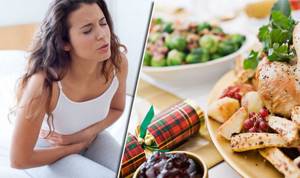
Menu for a week for pregnant women after poisoning
- 1 day - boiled rice porridge, decoctions of rose hips, black currants, blueberries with sugar, still mineral water, you need to eat 7-8 times.
- Day 2 – breakfast – pureed porridge, afternoon snack – apple compote jelly, lunch – chicken broth, dinner – mashed potatoes without butter and milk.
- Day 3 – breakfast – omelet without milk, lunch – rice soup with chicken, afternoon snack – apple and rosehip jelly, dinner – steamed white fish cutlets.
- Day 4 – breakfast – millet porridge with butter, lunch – fish broth with pieces of fish and rice, afternoon snack – kefir with toasted white bread, dinner – steamed minced veal.
- Day 5 – breakfast – boiled eggs, tea with milk, lunch – soup with eggs, steamed meatballs with rice, afternoon snack – diluted pineapple and apple juice, dinner – cottage cheese with kefir and honey.
- Day 6 – breakfast – steamed pudding, lunch – fish meatballs with sour cream sauce, afternoon snack – sweet fruit salad, dinner – baked potatoes with butter.
- Day 7 – breakfast: porridge with honey, lunch: vermicelli with chicken fillet, afternoon snack: decoction of flax seeds, dinner: meatloaf.
Drinking regime
The main key to a quick recovery from poisoning is proper drinking regimen. It will help remove toxins from the body and avoid dehydration. It is recommended to drink after each attack of vomiting or bowel movement. You need to drink little by little, in small sips. The liquid should not be cold, but not hot either.
First, it is recommended to take dehydration solutions prescribed by your doctor. They will help restore the disturbed water-salt balance. These are, for example, “Regidron”, “Gastrolit”, “Glucosolan”. A decoction of dill seeds and greens will help relieve bloating and increased gas formation. On the first day, only clean water and special medications are recommended. Then you can include other drinks:
- jelly and compotes from fruits or berries;
- tea without sugar;
- rice water, herbal infusions, rose hips, chamomile;
- still mineral water.
Weekly menu for poisoning due to hepatitis B
Proper nutrition is very important during the recovery period, especially when breastfeeding women.
A healthy nutrition menu for the week should look like this:
- 1 day – you can have some crackers from unsweetened white bread without crust, boiled rice porridge, rosehip compote without sugar.
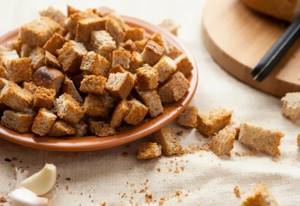
- Day 2 – warm water with a few grains of sugar or weak tea, natural yogurt without filler, 5-6 crackers (can be with kefir) divided into 6 doses, homemade chicken broth, pureed porridge, a glass of warm kefir for dinner.
- Day 3 – breakfast rice or millet porridge, lunch – rice soup with chicken or veal broth, afternoon snack – crackers with liquid yogurt, dinner – steamed chicken or minced veal cutlets.
- Day 4 – breakfast – steamed omelet, lunch – pollock fillet soup, afternoon snack – fruit jelly made from sweet juice, egg casserole.
- Day 5 – breakfast – cottage cheese casserole, lunch – vegetable soup with chicken and sour cream, afternoon snack – rosehip broth and Maria cookies, dinner – vinaigrette of boiled vegetables.
- Day 6 – semolina porridge with kefir, lunch – fish with mashed potatoes, afternoon snack – baked apple, dinner – boiled beef
- Day 7 – cottage cheese with baked apple puree, lunch – fish soup, vegetable salad with vegetable oil, afternoon snack – kefir with biscuits, dinner – baked vegetables.
After poisoning, the recovery period in children lasts longer than in adults, so they must follow a diet for a week more.
Article design: Mila Friedan
Sample menu
Nutritionists recommend that patients adhere to the following menu:
| Day of the week | First breakfast | Lunch | Dinner | Afternoon snack | Dinner | Before bedtime |
| Monday | Oatmeal | Banana | Boiled beef with rice | Baked apples | Vegetable stew | Curdled milk |
| Tuesday | Rice porrige | Dried fruits compote | Boiled veal with vegetables | Avocado | Boiled chicken meat with vegetables | Kefir |
| Wednesday | Buckwheat | Apple | Low-fat broth with chicken pieces | Plums | Beet salad | Ryazhenka |
| Thursday | Grated carrot salad | Apricot | Turkey breast with buckwheat porridge | Currant decoction | Pumpkin puree | Berry juice |
| Friday | Natural yogurt with berries | Rose hip decoction | Vegetable stew | Kefir | Fruit salad | Curdled milk |
| Saturday | Cottage cheese | Cranberry juice | Chicken pieces with stewed vegetables | Boiled egg | Zucchini puree | Currant decoction |
| Sunday | Oatmeal | Avocado | Low-fat broth, beef cutlets, rice | Apricot juice | Turkey breast with vegetables | Kefir |
It is recommended to include porridge, low-fat soups, and meat in the menu. Snack on fruits, berries, compotes.
We must not forget about dairy products: they are consumed during the afternoon snack, before bed. Kefir, fermented baked milk, yogurt and cottage cheese are allowed. Fruit juices are also acceptable.
The benefits and harms of dried bread for pancreatitis
To digest dried bread, the pancreas produces 2-3 times less enzymes than to digest a fresh product. It is the reduction of the load on the pancreas that doctors call one of the main conditions for keeping the disease in remission for a long time.
If pancreatitis has developed against the background of low acidity of gastric juice, it is recommended to dry rye bread, and against the background of high acidity - with the addition of rice or oatmeal.
Dried bread for pancreatitis is an excellent source of proteins and carbohydrates necessary for the constant regeneration of diseased pancreatic tissue and the gradual restoration of its functions.
Read: The benefits of dates for a woman’s body when losing weight
For this disease, only homemade dried bread is allowed to be consumed. Store-bought crackers containing a lot of flavorings, preservatives and other harmful additives are strictly prohibited.
To summarize, it is important to note that dried bread with pancreatitis should never be eaten dry. It should be well moistened with drink, soup, gravy or at least saliva and chewed thoroughly. Then the product will benefit the patient.
Consequences of not following the diet
If the principles of therapeutic nutrition are neglected, a person faces various complications from the gastrointestinal tract. The “lightest” and most common include:
- intestinal and stomach disorders with the occurrence of colitis and gastritis;
- intestinal dysbiosis;
- food allergies.
Important! All materials are for reference purposes only and are in no way an alternative to face-to-face consultation with a specialist.
This site uses cookies to identify site visitors: Google analytics, Yandex metrics, Google Adsense. If this is unacceptable to you, please open this page in anonymous mode.
source
What is dietary table No. 1a
Treatment after poisoning involves the use of dietary table No. 1a, which helps maintain electrolyte balance, reduce the severity of the inflammatory process, and prevent dehydration. It is also necessary to maintain a healthy combination of micronutrients, fats, carbohydrates and proteins.
Diet No. 1a recommends eating:
- Protein – 80 g, while the content of animal proteins should be 60-70%;
- Fats 80-90 g, vegetable fats at least 20%;
- Carbohydrates – 200 g.
The daily calorie content for such a diet is 1900-2000 kcal.
Fractional amounts of food are recommended. In the first three days, the daily volume of food is only 150-200 ml, gradually increasing it. This is necessary to reduce the gag reflex and awaken appetite.
You should drink at least 2 liters of fluid daily to flush out toxins and prevent dehydration. It is recommended not to eat, but only drink on the first day after intoxication. Take 50-100 ml of liquid every half hour so as not to provoke a new attack of vomiting. For drinking, use mineral still or boiled water. You can add Hydrolyte or Regidron to your drink.
Features of toxic infection in children
Food poisoning is the ingestion of harmful bacteria contained in spoiled foods of plant, animal and chemical origin.
The process of development of poisoning can be divided into three stages:
Latency is the period that passes from the moment harmful bacteria enter the body until they begin to penetrate the walls of the stomach and intestines, thereby causing the first symptoms of food poisoning. This stage is the most favorable to provide first aid and try to prevent the development of the disease.
Toxigenic - the stage when the symptoms of poisoning begin to manifest themselves in full. When they are first detected, it is immediately necessary to provide the necessary treatment, in the form of gastric lavage, cleansing enemas, medication, and a special diet. If the stage of poisoning has gone too far, then in this case it is necessary to contact a medical institution for help.
Recovery - after ridding the body of harmful substances, it needs time to recover from the shock it has experienced.
Causes of childhood food poisoning
In order to avoid the appearance of symptoms and treatment of poisoning in a child, you must first know in what ways you can get sick:
- Eating food products that have expired or are subject to improper storage. In them, especially in dairy products, harmful organisms begin to develop, which cause poisoning.
- Eating foods that have not undergone the necessary processing, for example, meat or fish.
- Eating mushrooms, plants or berries that are unsuitable for food.
- Accidental ingestion of any chemical substances into the body with food.
Signs of food poisoning
Symptoms of poisoning in a child appear within a few hours after consuming the forbidden product:
- First of all, restlessness begins in the digestive system, which after poisoning provokes frequent diarrhea or vomiting; there are cases of their simultaneous appearance. The stool may be mixed with mucus.
- Painful sensations are felt in the abdomen, especially in the stomach area.
- The general state of health worsens, body temperature rises, weakness, drowsiness, and loss of appetite appear.
- If vomiting and diarrhea occur frequently, dehydration may occur, which is expressed by sharper facial features and dry skin. In addition, convulsions may occur. You can read about what to do if a child is vomiting in the article: Vomiting in a child: reasons, how to stop, review of medications.
Depending on the type and degree of poisoning, the duration of the symptoms depends, which may pass in a couple of days, or may develop serious health complications, including death.
Treatment of salmonellosis poisoning during pregnancy
What can pregnant women do if they are poisoned by food contaminated with salmonella?
- Detoxify with sorbents.
- Drinking saline solutions.
- Diet.
- Antibiotics, the need for which is determined by the doctor.
There are several forms of salmonellosis, depending on the affected parts of the digestive tract, so the treatment of such poisoning can vary greatly. Hospitalization is necessary for moderate and severe cases. But an examination by a therapist or infectious disease specialist is required in all even mild cases of poisoning.
The consequences for the child and mother are similar to those mentioned above.
Recipes for diet foods
Dietary dishes are easy to prepare; they need to be prepared immediately before consumption; they cannot be eaten on the second day.
What can be prepared to treat poisoning:
- Healthy broth. Boil skinless chicken breast in 5 liters of water, drain the water after boiling. Re-fill the meat with water in the same volume, after boiling, add 100 g of finely chopped carrots, a small whole peeled onion. Cook until the meat is done, remove the onion before serving.
- Oatmeal and pear jelly. Mix 50 g of dried fruits and 30 g of flakes, add 400 ml of water, bring the mixture to a boil, cook over low heat for a quarter of an hour. The drink can be given to children older than six months to eliminate signs of poisoning.
- Rice porridge. Rinse 45 g of rice several times with cold water, add 300 ml of water, cook for 20 minutes.
- Steamed meatballs. Boil 50 g of rice until half cooked, cool, combine with 220 g of minced chicken, add a little salt, form into small balls. Cook in a steamer for 35–45 minutes.
- Nutritional cocktail. Grind the pulp of one banana, pour in 200 ml of milk, beat thoroughly in a blender. This drink can be consumed 3-4 days after poisoning; it satisfies hunger well and replenishes the deficiency of vitamins and microelements.
The diet after food, alcohol, or drug poisoning is designed to quickly remove toxins, restore the functioning of the digestive system, and eliminate nutritional deficiencies. If you eat improperly, it is difficult for the body to cope with intoxication, which can lead to the development of serious complications.
Rate this article ( 2 ratings, average 5.00 out of 5)
Poisoning can occur when consuming low-quality food, alcohol, various chemicals, as well as when pathogenic microorganisms penetrate the digestive tract. This condition is accompanied by characteristic symptoms: vomiting, diarrhea, intoxication and hyperthermia. It should be noted that for recovery it is necessary to follow a therapeutic diet.

